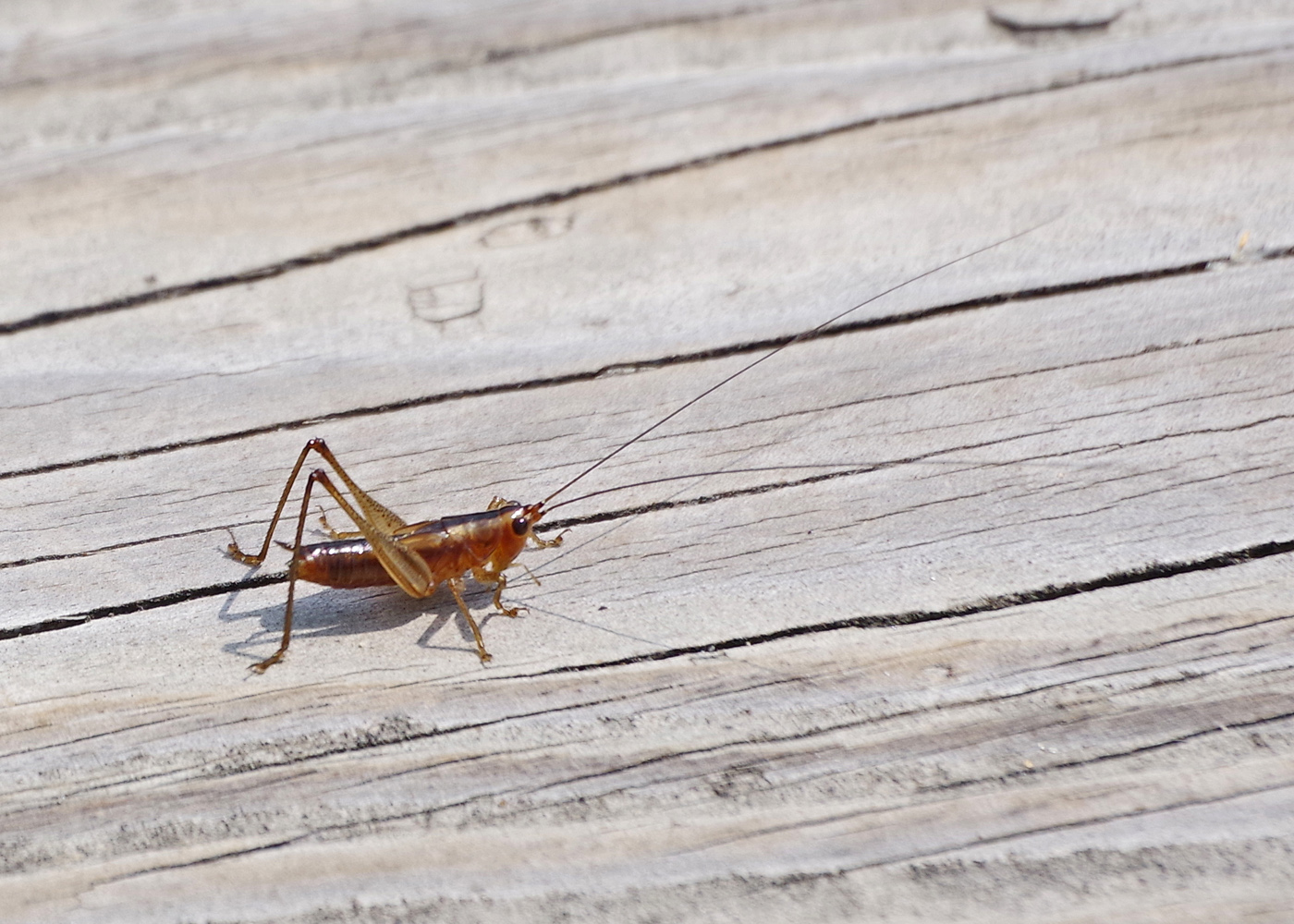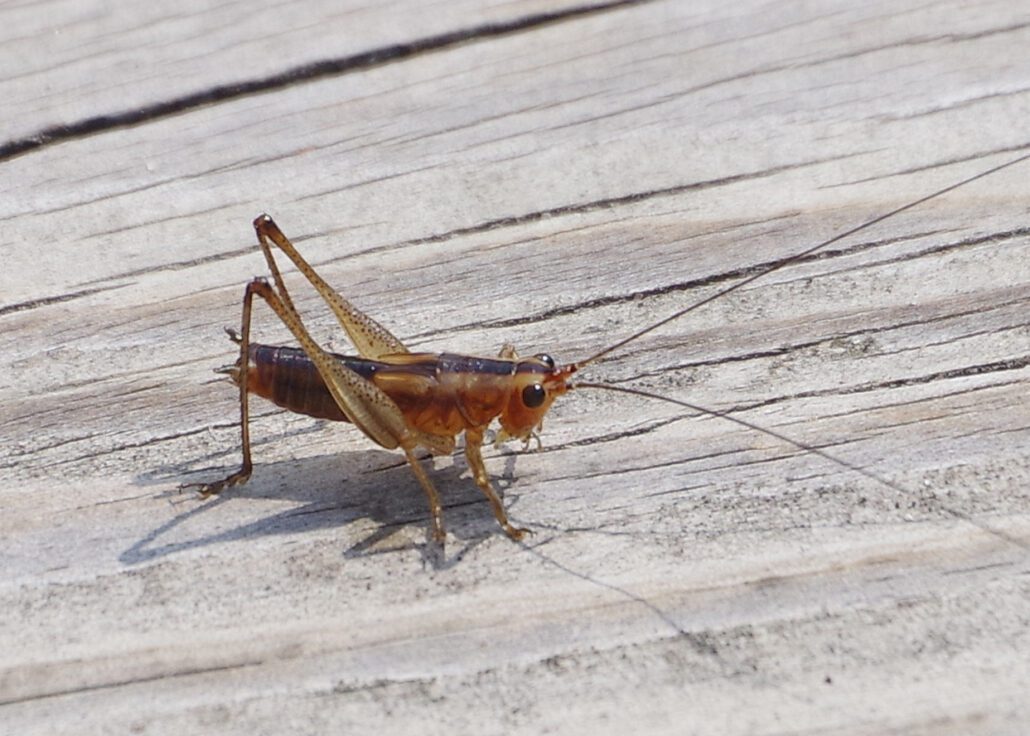
by Kate Redmond
Bug o’the Week Long-tailed Meadow Katydid
Howdy, BugFans.
At first glance, Meadow Katydids look like small grasshoppers, but grasshoppers (family Acrididae) have antennae of a reasonable length, and katydids (family Tettigoniidae) have such long antennae (you have to back up a bit to get the whole antenna in a picture) that you wonder how they maneuver through the vegetation – and life (those antennae, of course are highly sensory and are exactly what allow them to navigate through life). In her “Naturally Curious” blog, Mary Holland writes “Insect antennae are among the most sensitive and selective chemical-sensing organs in the animal kingdom. They detect information crucial to an insect’s survival, including odors, sounds, humidity, changes in water vapor concentration and air speed. Antennae are capable of these feats because of the sensory receptors covering them which bind to free-floating molecules.” And they’re tactile, too.
Behaviorally, grasshoppers fling themselves into the air at the slightest provocation (remember, their action is driven by both legs and wings), while Meadow Katydids are more likely to skulk away into the thicket with a series of short hops onto the backsides of leaves.
Meadow Katydids are in the tribe Conocephalini (literally “cone heads”), which is divided into the Greater Meadow Katydids (genus Orchelimum) and Lesser/Smaller Meadow Katydids (genus Conocephalus). Lesser Meadow Katydids were mentioned briefly in an early BOTW (https://uwm.edu/field-station/tettigoniidae-two/), and one of the Greater Meadow Katydids was featured in a BOTW a few years ago https://uwm.edu/field-station/black-legged-meadow-katydid/. There are about 160 species of Lesser Meadow Katydids worldwide and 18 in North America, and they’re found in grasslands and wetlands, and on woodland edges.

With bodies under ¾”, they’re not huge. They can be tough to tell apart when they’re just sitting on a blade of grass, and some species come both in a variety of color forms and with short or long wings, but if you get a good look, the females’ ovipositors are pretty distinctive, even as nymphs, and so are the males’ claspers (cerci) https://sina.orthsoc.org/g220a.htm. Their songs, mostly sung in late afternoon and evening, can be hard to hear. Straight-lanced Meadow Katydid are a fairly common species in Wisconsin – here’s a male nymph and an adult female https://bugguide.net/node/view/2218360/bgimage https://bugguide.net/node/view/1579703/bgimage.
Females use those impressive ovipositors to punch holes in vegetation, into the soil, or even under tree bark to deposit their eggs. The eggs overwinter, and the nymphs pop out the next year looking pretty much like their eventual adult form (incomplete metamorphosis). Meadow Katydids are omnivores, supplementing a diet of the leaves, seeds, flowers, and pollen of non-woody plants with the odd, tiny insect.
The BugLady always enjoys coming across nature articles by Matt Pelikan in the Martha’s Vineyard Times as she does her research. Here’s one about Meadow Katydids https://www.mvtimes.com/2019/09/04/wild-side-meadow-katydids/.
Enter the LONG-TAILED MEADOW KATYDID (Conocephalus attenuatus), aka the Lance-tailed Meadow Grasshopper (both referring to the female’s ovipositor); Lisa Rainsong, in her “Listening in Nature” blogspot calls it the Red Marsh Katydid. They are habitat specialists – residents of sedge and cattail marshes with standing water in much of the northeastern quadrant of North America. They’re not common overall but can be locally numerous. By all accounts, the BugLady was really lucky to see this one without resorting to a flashlight and hip waders.
LTMKs feed on cattails and sedges, especially the seeds https://bugguide.net/node/view/1725335/bgimage.
Bugguide.net says that they’re “Typically either all red or red with green limbs.” Rainsong points out that “The color blends very well with reddish cattail heads, and that’s a likely place to find this katydid.” Here’s a short-winged male and female https://bugguide.net/node/view/1863860/bgimage and https://bugguide.net/node/view/1593979/bgimage, and a long-winged male and female https://bugguide.net/node/view/1588827/bgimage and https://bugguide.net/node/view/1119893/bgimage, and there’s a nice collection of pictures here http://listeninginnature.blogspot.com/2013/11/the-red-katydids.html. Their soft song has been described as a continuous, pulsing rattle, rather than a whirr, sung mostly after sunset http://songsofinsects.com/katydids/long-tailed-meadow-katydid.
When LTMKs copulate, the male delivers a “twofer” – a sperm packet and an attached gelatinous glob called a spermatophylax. The female plucks off the spermatophylax, which contains nutrients that may ensure successful egg-laying, but it’s a bribe. As she eats, the sperm are being absorbed from the spermatophore at her opposite end. When she finishes her snack, the female detaches the spermatophore, so while she’s eating, the clock is ticking for the male’s gene pool. Chemicals in the spermatophylax may also dim her interest in other males temporarily. For a good, illustrated, PG explanation of the process in one of the Greater Meadow Katydids, see https://natureinquiries.wordpress.com/2013/03/27/spermatophylax/.
Kate Redmond, The BugLady
Bug of the Week archives:
http://uwm.edu/field-station/category/bug-of-the-week/
